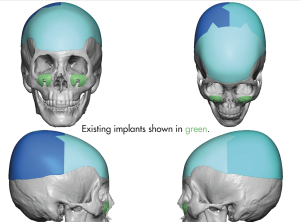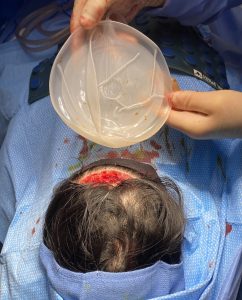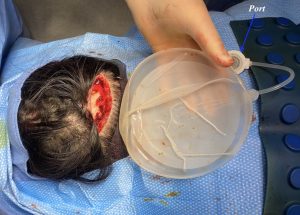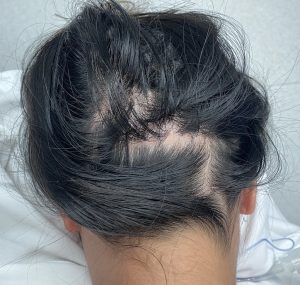Background: Custom implants provide the most effective and significant method for aesthetic skull augmentation. By expanding the outer surface of the skull through placement of an onlay implant the overlying scalp is stretched and the head shape changed. While any shape and size of skull implant can be designed that doesn’t mean there is enough stretch of the scalp to accommodate it.
Thus determining whether a skull implant can be safely implanted is an important preoperative consideration. There is no exact science to making that determination but my extensive experience has shown that the implant volume is more important than any of its linear measurements. (thicknesses) While scalp thicknesses and stretch do differ between patients a good general guideline is 150ccs of implant volume. If the implant volume exceed that amount of first stage scalp expander is needed to create the necessary scalp stretch so the implant can be safely placed.
In placing a scalp tissue expander there are several basic principles that come from its historic use in reconstructive surgery. When possible the placement incisions should not be over there implant and preferably as far away as possible. Also if the incision is adjacent to the implant it should be perpendicular to the direction of the expansion. Both concepts are designed to avoid placing stretch on the incision to avoid undue widening as well potential incisional dehiscence.



A small head, large volume skull implant and a prior strip harvest for hair transplantation all indicate the need for a 1st stage scalp expander. Due to the tightness of the scalp I don’t put in any fill of the expander at the time of surgery. I do a 10cc fill before the patient leaves for home. They will then d0 10cc fills every 2 to 3 days until the volume of the expander equals the volume of the 2nd stage skull implant placement. This is usually a 6 to 8 week process to get the expander inflated adequately.
Case Highlights:
1) Large custom skull implants require a first stage scalp expander.
2) One of the principles of scalp expansion in skull implants is to have the diameter of the scalp expander as close in size to that of the footprint of the implant.
3) A hair transplant scar provides a convenient access for scalp tissue expander placement…and it is also the absolute indication for the need for a scalp expander.
Dr. Barry Eppley
World-Renowned Plastic Surgeon



